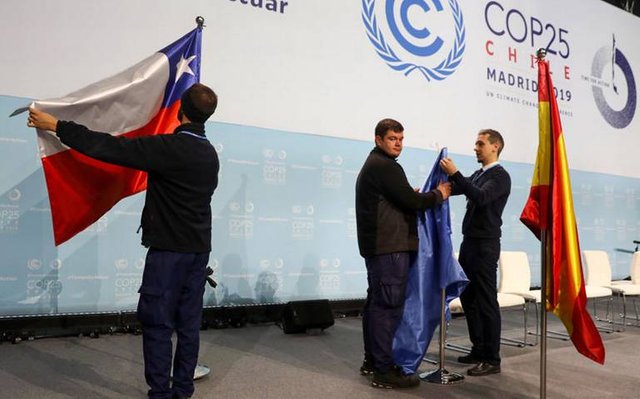Entre el 2 y el 13 de diciembre, Madrid acoge la esperada COP 25 -Between December 2 and 13, Madrid hosts the expected COP 25
¿Qué es la COP?

English version at the end
Se trata de la reunión de los representantes de los países firmantes del Convención Marco de Naciones Unidas sobre el Cambio Climático (CMNUCC), que se acordó en 1992 y entró en vigor dos años después.
COP es la sigla que resume el nombre de esa reunión: Conferencia de las Partes de la CMNUCC. Y la primera, la COP1, se celebró en Berlín en 1995.
¿Por qué es importante la COP 25?
Durante esta reunión se busca reglamentar el Acuerdo de París y así sentar bases claras de qué y cómo harán los países para cumplir sus compromisos de no superar 1,5ºC el aumento de temperaturas globales y de alcanzar un balance neto cero de las emisiones de gases de efecto invernadero en la segunda segunda mitad del presente siglo. Con los compromisos actuales se espera que las temperaturas globales aumenten entre 3.4 y 3.9°C este siglo, lo que traería impactos climáticos destructivos y de gran alcance. Según la ONU, se necesitan reducciones de las emisiones del 7,6% anual desde 2020 hasta 2030 para cumplir el objetivo acordado internacionalmente de limitar el aumento de las temperaturas a 1,5 °C en comparación con niveles preindustriales. Los científicos coinciden en que es una tarea difícil y que la ventana de oportunidad se está cerrando.
¿Cuál es el objetivo de la COP?
Debido a que la CMNUCC tenía límites no vinculantes sobre las emisiones de gases de efecto invernadero de los países y tampoco tenía un mecanismo de cumplimiento, se negociaron varias extensiones de este tratado durante las COP recientes, incluido el Acuerdo de París de 2015. Este pacto fijó el compromiso de los países de intensificar los esfuerzos para limitar el calentamiento global a 1,5°C por encima de las temperaturas preindustriales; también se fijó impulsar el financiamiento de la acción contra el cambio climático.
De esta forma, los objetivos preestablecidos de la COP son:
- Monitorear el cumplimiento de la CMNUCC y del Acuerdo de París.
- Realizar un estado de situación de las pérdidas y daños derivados de los impactos del cambio climático.
- Evaluar la adaptación al cambio climático y sus efectos.
- Revisar el apoyo financiero de los países industrializados y la transferencia tecnológica necesarios para hacerle frente.
- Puesta a punto de la situación de los países en desarrollo más vulnerables al cambio climático.
English Version
Between December 2 and 13, Madrid hosts the expected COP 25, where almost 200 leaders meet to make decisions that can mitigate the effects of climate change.
What is the COP?

This is the meeting of the representatives of the signatory countries of the United Nations Framework Convention on Climate Change (UNFCCC), which was agreed in 1992 and entered into force two years later.
COP is the acronym that summarizes the name of that meeting: Conference of the Parties to the UNFCCC. And the first, COP1, was held in Berlin in 1995.
Why is COP 25 important?
During this meeting it is sought to regulate the Paris Agreement and thus lay down clear bases of what and how countries will do to fulfill their commitments of not exceeding 1.5ºC the increase in global temperatures and reaching a zero net balance of gas emissions from greenhouse effect in the second second half of this century. With current commitments global temperatures are expected to rise between 3.4 and 3.9 ° C this century, which would bring destructive and far-reaching climatic impacts. According to the UN, emissions reductions of 7.6% per year from 2020 to 2030 are needed to meet the internationally agreed objective of limiting the increase in temperatures to 1.5 ° C compared to pre-industrial levels. Scientists agree that it is a difficult task and that the window of opportunity is closing.
What is the purpose of the COP?
Because the UNFCCC had non-binding limits on greenhouse gas emissions from countries and also did not have a compliance mechanism, several extensions of this agreement were negotiated during recent POPs, including the 2015 Paris Agreement. This pact set the countries commitment to intensify efforts to limit global warming to 1.5 ° C above pre-industrial temperatures; It was also set to boost the financing of action against climate change.
In this way, the preset objectives of the COP are:
- Monitor compliance with the UNFCCC and the Paris Agreement.
- Perform a state of loss and damage arising from the impacts of climate change.
- Evaluate adaptation to climate change and its effects.
- Review the financial support of industrialized countries and the technology transfer necessary to address it.
- Development of the situation of developing countries most vulnerable to climate change.
Posted from my blog with SteemPress : http://davinzho.repollo.org/2019/12/01/entre-el-2-y-el-13-de-diciembre-madrid-acoge-la-esperada-cop-25-between-december-2-and-13-madrid-hosts-the-expected-cop-25/